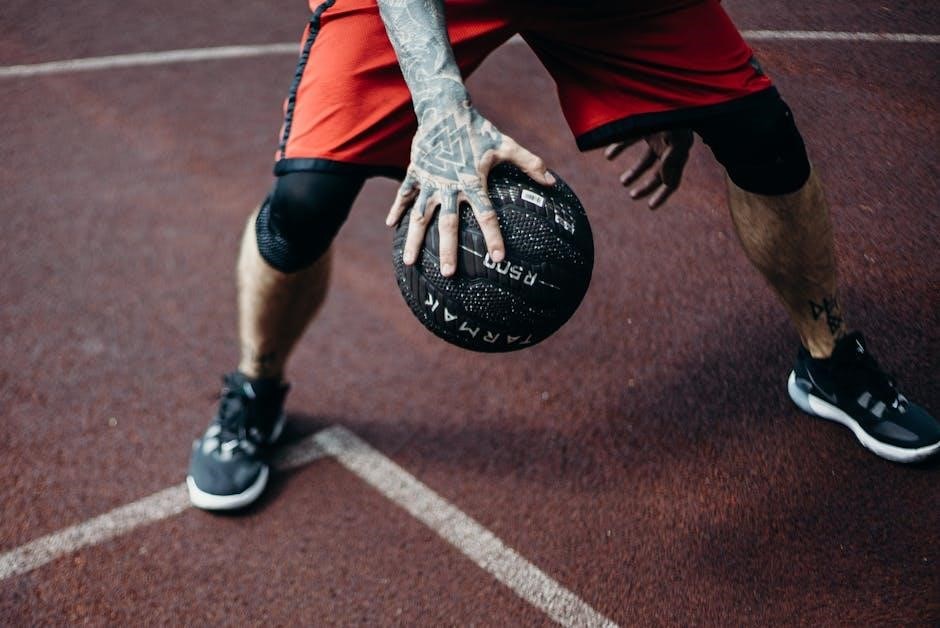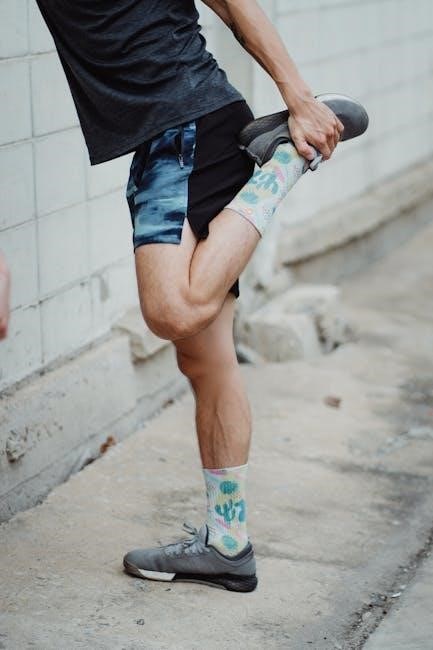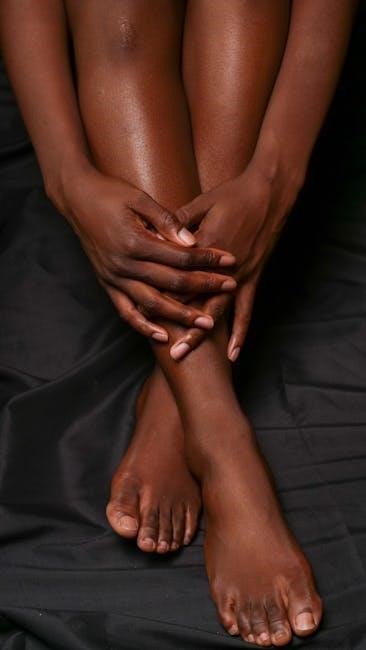
ACL knee braces provide essential support and stability for individuals recovering from ACL injuries or surgery, aiding in rehabilitation and preventing reinjury during physical activity.
Overview of ACL Injuries and the Role of Knee Braces
ACL injuries are common among athletes, often requiring surgical intervention or conservative treatment. Knee braces play a critical role in immobilizing and stabilizing the knee post-injury or surgery. They provide essential support during rehabilitation, preventing excessive movement and promoting proper healing. Braces also help reduce pain and swelling, enabling patients to perform daily activities and rehabilitation exercises safely. Their use is tailored to the severity of the injury, offering a structured path toward recovery and preventing further damage or reinjury.
Importance of Proper Knee Support in Rehabilitation
Importance of Proper Knee Support in Rehabilitation
Proper knee support is vital during ACL rehabilitation to ensure stability, prevent excessive movement, and promote proper healing. Knee braces immobilize the knee, reducing pain and swelling, while allowing controlled flexibility for exercises. They provide essential stability, enabling patients to perform daily activities and rehabilitation exercises safely. Proper support accelerates recovery, minimizes the risk of reinjury, and enhances the effectiveness of physical therapy, ultimately restoring knee function and strength for long-term stability and mobility.
Understanding ACL Injuries
The ACL is a crucial ligament stabilizing the knee. Injuries often occur during sports, causing pain, instability, and limited mobility, requiring prompt diagnosis for effective treatment.
What is the Anterior Cruciate Ligament (ACL)?
The ACL is a vital ligament located inside the knee joint, connecting the femur (thigh bone) to the tibia (shin bone). It plays a crucial role in stabilizing the knee, preventing excessive forward movement of the tibia, and supporting rotational movements. Injuries to the ACL are common in sports, often leading to pain, swelling, and instability, necessitating medical attention and sometimes surgical intervention to restore knee function.
Common Causes and Symptoms of ACL Injuries
ACL injuries often occur during sudden stops, pivoting, or direct blows to the knee, commonly in sports like soccer or basketball. Symptoms include immediate pain, swelling, instability, and a popping sound at the time of injury. Bruising, difficulty walking, and a feeling of the knee “giving way” are also typical. Prompt medical evaluation is essential to confirm the diagnosis and determine the severity of the injury.

Choosing the Right ACL Knee Brace
Selecting the right ACL knee brace involves considering your specific support needs, activity level, and fit. Both rigid and soft braces are options, depending on your lifestyle.
Types of Knee Braces for ACL Support
ACL knee braces come in various types, including rigid, soft, and hinged designs. Rigid braces offer maximum stability, often used post-surgery, while soft braces provide mild support for minor injuries. Hinged braces allow controlled movement, ideal for rehabilitation. Sleeve-style braces offer compression and are lightweight for daily activities. Each type addresses specific needs, ensuring proper knee stability and protection during recovery or sports activities.
Key Features to Consider When Selecting a Knee Brace
When choosing an ACL knee brace, consider support level, adjustability, and hinges for controlled movement. Look for breathable, durable materials and a comfortable fit. Additional features like adjustable straps and patellar support enhance stability. Some braces offer rigid frames for post-surgery use, while others provide lightweight compression for daily activities. Ensure the brace aligns with your activity level and injury severity for optimal protection and recovery support.

Wearing and Using an ACL Knee Brace
Wearing an ACL knee brace ensures proper fitting and adjustment for optimal support during rehabilitation and daily activities, promoting stability and comfort while preventing further injury.
Proper Fitting and Adjustment Techniques
Proper fitting ensures optimal support and stability. Adjust straps while standing or sitting with the knee straight, snug but not overly tight. Avoid over-tightening, as it may restrict movement. For models like DonJoy braces, follow manufacturer guidelines for precise adjustment. Regularly check the fit, especially after swelling reduces. Ensure the brace doesn’t slip during use. Always prioritize comfort and stability for effective recovery and prevention of further injury.
Exercises and Activities to Perform While Wearing the Brace
While wearing an ACL brace, focus on low-impact exercises like straight leg raises, wall slides, and gentle hamstring stretches. Avoid high-impact activities to prevent strain. Use the brace during physical therapy sessions to enhance stability. Perform balance training on a soft surface to improve knee stability. Consider swimming or cycling for low-impact cardio. Always maintain proper form and consult your therapist for tailored exercises to ensure safe and effective recovery.

Rehabilitation Techniques with an ACL Knee Brace
ACL knee braces support structured rehabilitation by stabilizing the knee during physical therapy, protecting the ligament, and enabling controlled exercises to promote healing and strength recovery.
Immediate Post-Surgery Care and Brace Usage
After ACL surgery, a knee brace is essential to immobilize and protect the knee, allowing proper healing. Patients often use a knee immobilizer or fracture brace for 24-48 hours post-op. Elevation, ice therapy, and crutches are recommended to reduce swelling and pain. The brace ensures the knee remains straight, preventing excessive movement that could disrupt the graft. Pain management and monitoring for complications are critical during this phase. Proper brace usage supports early recovery and prepares the knee for subsequent rehabilitation exercises.
Physical Therapy Exercises for ACL Recovery
Physical therapy is crucial for ACL recovery, focusing on restoring strength, flexibility, and stability. Common exercises include straight-leg raises, heel slides, and wall sits. Patients often perform these while wearing a knee brace to ensure proper alignment and support. Gradually introducing weight-bearing activities and balance exercises helps improve function. Strengthening the surrounding muscles, such as the quadriceps and hamstrings, is essential to enhance knee stability and reduce the risk of reinjury during the rehabilitation process.
Comparing Different ACL Knee Braces
ACL knee braces vary in design, support, and adjustability, with brands like DonJoy offering clinically proven options. Rigid braces provide maximum stability, while soft braces allow more mobility.
Popular Brands and Models of ACL Knee Braces
Leading brands like DonJoy, Push Ortho, and Össur offer high-quality ACL knee braces. DonJoy’s Playmaker II and Legend are popular for their durability and support. Push Ortho’s ACL models, such as the ACL FF, provide excellent stability. Össur’s CTi knee brace is known for its lightweight design. These brands cater to various needs, ensuring optimal recovery and protection for ACL injuries, with models ranging from rigid to soft braces.
Pros and Cons of Rigid vs. Soft Braces
Rigid braces offer superior stability, ideal for post-surgery recovery, but can be bulky and less comfortable. Soft braces provide flexibility and comfort, suitable for rehabilitation, but may lack the support needed for severe instability. Choosing between them depends on individual needs, recovery phase, and activity level, ensuring optimal knee protection and mobility during ACL recovery.

The Role of Knee Braces in ACL Rehabilitation
Knee braces provide critical support and protection, aiding in stability and healing during ACL recovery while preventing excessive movement and reinjury, especially post-surgery and during physical therapy.
How Braces Support Knee Stability During Recovery
Knee braces provide essential stability by limiting excessive movement and protecting the ACL during recovery. They prevent strain on the ligament, allowing it to heal properly. Braces also enhance confidence during physical therapy, enabling patients to perform exercises without fear of reinjury. By maintaining proper knee alignment, they promote a safe environment for rehabilitation, ensuring the ACL heals effectively and reducing the risk of further damage or instability.
Long-Term Use of Braces for Preventing Reinjury
Long-term use of knee braces can significantly reduce the risk of ACL reinjury, especially for athletes returning to high-risk sports. Braces provide ongoing support and stability, compensating for weakened ligaments and muscles. They act as a protective barrier, minimizing stress on the knee during dynamic movements. Over time, consistent use helps maintain joint alignment and reduces the likelihood of further damage, making them a crucial component of long-term injury prevention strategies for ACL patients.
ACL knee braces play a vital role in supporting knee stability, aiding recovery, and preventing reinjury, making them an essential tool for managing ACL-related injuries effectively.
Key Takeaways for Effective ACL Recovery with a Knee Brace
A properly fitted ACL knee brace enhances stability, reduces reinjury risk, and supports rehabilitation. Consistent use alongside physical therapy promotes optimal healing. Regular exercises, like straight leg raises, strengthen surrounding muscles. Proper brace adjustment ensures comfort and effectiveness. Long-term use can prevent future injuries, especially during sports. Combining these strategies fosters a successful recovery, enabling individuals to regain knee function and confidently return to daily activities or athletic pursuits.
Future Considerations for Knee Brace Technology
Future advancements in ACL knee brace technology may include smart braces with sensors to monitor stability and track progress. Customizable braces using 3D printing could offer better fit and support. Integration with physical therapy apps could enhance recovery. Innovations in materials, such as lightweight and breathable designs, may improve comfort. Additionally, AI-driven adjustments could optimize brace settings for individual needs, potentially reducing recovery time and improving outcomes for ACL patients.